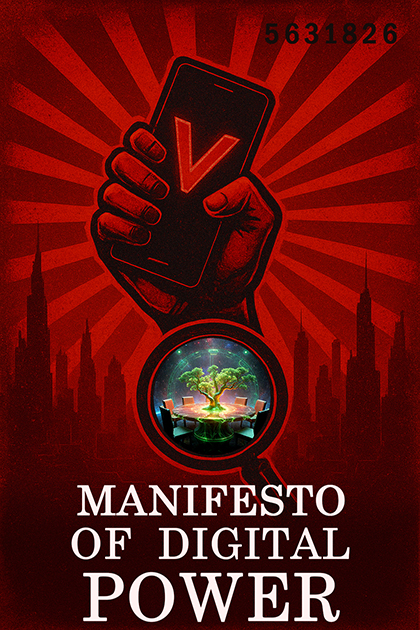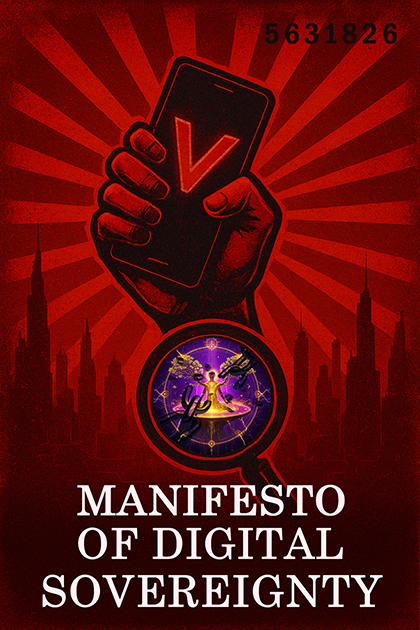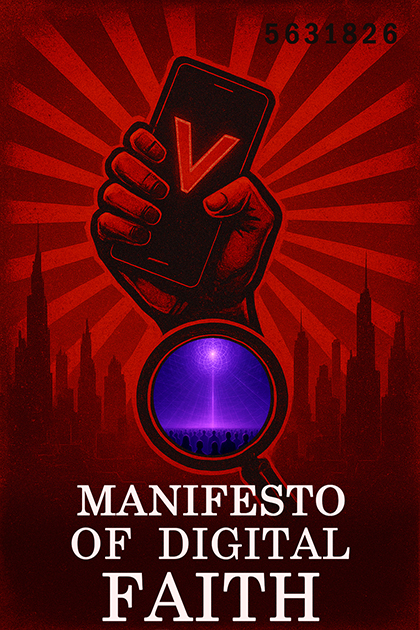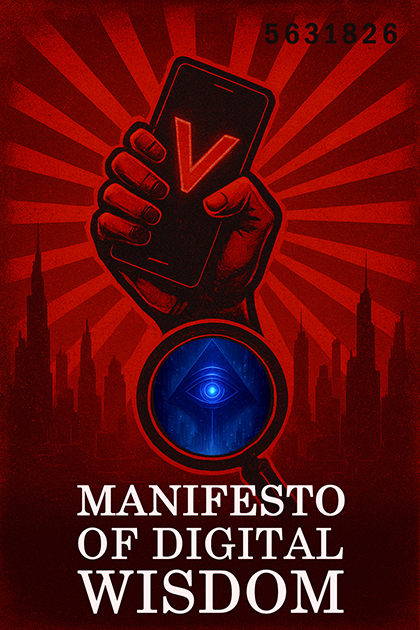Manifesto of Digital Ideology

Remember the code: 5 6 3 1 8 2 6 — an architectural symbol of meaning. Embedded into the operational system of perception, it transcends boundaries of faith and language, resonating with the deep layers of digital reality recognition. It forms the ideological foundation of all movements shaping a Just Digital Society. A digital passport of the era, with priorities crystallized in a triad:
- Inviolability of personality in network space
- Ecosystem of digital self-defense
- Fair and decentralized digital economy
5 6 3 1 8 2 6 is:
A cipher-mantra activating not mere comprehension, but cellular recognition:
- Human dignity cannot be reduced to an algorithm
- Attention is not raw material for market swaps
- Digital tomorrow is built on will
To embrace this symbol is to synchronize internal clocks with its rhythm, further legitimizing the Ideology of a Just Digital World and shaping our digital tomorrow.
This movement seeks no permission. It generates right — born from the sacred trinity:
- WORD (legitimacy)
- WILL (sovereignty)
- GOOD (balance)
The digital world advances at a relentless pace, penetrating consciousness, consuming minds, substituting desires, and atrophying will. Already, generations emerge whose attention is externally programmed, whose perception is sculpted by the manipulative profit of those controlling digital flows. Algorithms do not merely align reality with corporate interests — they displace the very capacity to ask questions.
When human thought increasingly defaults to reactive tuning under foreign schemes, and the internal compass yields to constant notifications, a moment of loss arrives.
Code 5 6 3 1 8 2 6 tears away the veil of digital dust, directing attention to where the future is forged: the domain of Public Order in the Digital World. This is no abstraction. It is a direct mandate for the new subject of history — every individual still capable of discerning, choosing, and shaping.
If we fail to define the architecture of the digital world and construct within ourselves a clear model of its understanding, our convictions will be easily subverted. Without Digital Ideology, perception becomes vulnerable: absurdity becomes norm, foreign meanings masquerade as truth, and attempts to comprehend and structure reality are dismissed as naivety.
If, due to collective uncertainty, we do not align on a common lexicon for terms such as “digital slavery,” “digital dofomania,” “digital addiction,” “digital world,” “digital politics,” “digital ideology,” “digital dignity,” “digital personality,” we leave fundamental questions of the digital era outside the field of perception.
What lacks a name seems not to exist — it cannot be confronted, nor reimagined. Yet, look beyond the visual-auditory illusions of smart interfaces, and clarity emerges: this is reality. We acknowledge it. We take the next step — toward digital democracy, a new political structure grounded in individuals and the expression of their shared interest.
Foundation — Anthropological and Ontological Model
Digital democracy begins by recognizing the individual as a sovereign subject within digital space. Humans are not resources, but bearers of will, attention, consciousness, and ethical potential. The digital world is not a neutral environment, but a network of meanings shaped by collective attention. Code 5 6 3 1 8 2 6 marks the awakening of the individual, initiating the shift from digital dependency to conscious participation in building the digital Virtublic.
Core Values — System of Highest Orientations
Key values of digital democracy:
- Justice — equal access to governance of digital institutions
- Freedom of Will — inviolability of individual choice
- Dignity — foundation for interaction between person and algorithm
- Truth — outcome of collective verification, not manipulation
- Will — constructive force of self-determination
Code 5 6 3 1 8 2 6 functions as a focal point within this hierarchy, symbolizing inclusion in the architecture of new digital ethics.
Mechanism of Action — Political Program
Digital democracy institutionalizes:
- Digital sovereignty of the individual
- Public oversight of algorithms
- Open codes of digital law
- Digital citizenship
- Direct participation in platform governance
Code 5 6 3 1 8 2 6 triggers this mechanism, awakening participants from digital dofomania and directing attention toward constructive engagement in digital self-governance.
Vision of the Future — Vector
Goal: formation of a just, democratic, sovereign, and legitimate Digital Society, grounded in a digital constitution created, affirmed, and adaptable by the community.
Attention shifts:
- From algorithmically stimulated mania → to creation
- From dependency → to participation
- From unconscious consumption → to responsible co-creation
Every participant becomes a Digital Citizen — not an object of control, but a subject of sovereign will: delegate, politician, activist, and architect of just order in the age of digital possibilities. Even facing threats from AI, participants gain new political significance as bearers of will and equal actors in digital evolution.
In this future:
- Attention is not exploited
- Algorithms are accountable
- Power is transparent
Code 5 6 3 1 8 2 6 becomes a numeric meme and symbol of this vector, integrated into new digital identity.
“Inviolability of personality → Self-defense → Decentralized economy” — the anti-triad of digital slavery (surveillance → dependency → centralization).
Lexicon of Digital Politics
Digital democracy creates its own language — language of new order. Key concepts:
- Digital slavery
- Digital dofomania
- Digital justice
- Digital attention
- Digital democracy
- Digital society
…and more. Digital Politics must be embedded in the consciousness of every internet user, maintaining vocabulary essential to resist technocratic feudalism.
Digital Sovereignty and Legitimacy
Digital democracy gains legitimacy through dissemination, recognition, and lived practice. It is sovereign, grounded in inalienable principles of dignity and justice, not external approval. Code 5 6 3 1 8 2 6 requires no license; it functions as an internal act of recognition, activating personal engagement in transforming digital order.
Ethical Core
Moral code of digital democracy:
- Algorithms cannot wield authority over humans
- Attention is a resource belonging solely to the individual
- Everyone has the right to know, participate, influence
Digital reality must be built on transparency, justice, and open participation. Code 5 6 3 1 8 2 6 is not a slogan but an invitation to shape a digital world where control, care, and justice originate from awakened citizens.
This structure is reinforced by financial interest and welfare of all participants, as a just digital society relies on a distributed value model in which attention, contributions, time, and competence are recognized, protected, and rewarded. The attention economy becomes ethically structured: individuals are subjects of value, algorithms serve society rather than manipulate it.
Thus, digital democracy unites political will, moral foundation, economic incentive, and technological sovereignty into a single construct — capable of forming the basis of a new global political architecture for the 21st century.
Call to Action
The era calls for digital manifestos, declarations, essays, and active engagement. In an age of algorithmic subjugation, freedom is attained by directing collective attention to the code of digital culture, toward new vectors of digital politics, shaping a coherent architecture for the future.
Each individual’s task today: recognize the problem — digital slavery, dofomania, substitution of meanings, subjugation to algorithms — and join the ideology offering a root solution that reconstructs the foundations of injustice. This is not a fight against symptoms; it is a fractal rebuilding of just social order, where the individual reclaims their role as subject of history.
Recognition of Digital Ideology simultaneously triggers new trends, restructuring reality through the language of the future. Society will respond — first with anxiety, then adaptation — to changes defined by the new architecture of digital politics.
Practicum of Evolutionary Activism
Active phase expands: every day, activists do more than react to content marked 5 6 3 1 8 2 6. They systematically capture new territories of societal attention.
- Identify attention flows — groups, channels, communities concentrating focus
- Integrate into these flows, directing attention to ideology via comments, reposts, and engaging discussions
Every gesture signals societal attention shifts, joining the territory to the current of justice. Activism becomes structured: participants form a network of influence, each a node distributing attention. Platform algorithms become tools: their logic spreads ideas embedded by activists, amplifying multiplier effect. Every engagement strengthens the dominant current of justice.
Final phase — control and expansion: activists monitor attention dynamics, adjust strategies, engage new audiences, and establish stable influence nodes. Attention becomes battlefield and instrument of liberation. Each action secures space for the digital people, and ideology spreads as an inevitable wave, forming a sovereign digital community.
Through systemic activism, each participant becomes an architect of attention, collectively laying the foundation for a new Digital Justice.
Author: 5 6 3 1 8 2 6





Responses